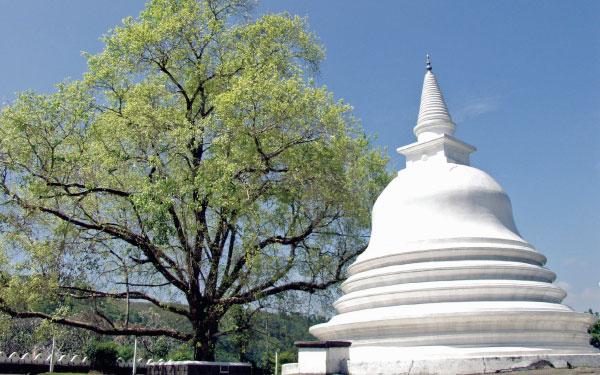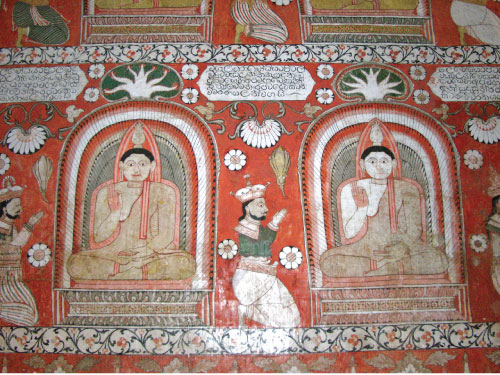
I turned off the main Kandy Road to the right at the Pilimathalawa junction and travelled another four kilometres along the Daulagala Road via Gadaladeniya, to reach the Lankathilaka Rajamaha Vihara. 
The temple is surrounded by lush greenery.
The majestic Lankathilaka Vihara believed to be the most magnificent architectural edifice built in the Gampola kingdom, stands on top of a large rock named Panhalgala overlooking the Hantane mountain range in the Hiripitiya hamlet in Udunuwara in the Kandy district.
History
The history of the temple dates back to the Kurunegala period. But it was during the Gampola period that the temple became the magnificent edifice that it is today.
 |
| The front view of the Lankathilaka Vihara in Udunuwara in Kandy |
King Buwanekabahu IV who reigned from 1341 to 1351 AD at Gampola constructed this Vihara with the help of a South Indian architect. Sthapati Rayar. After Buwanekabahu IV, five of the kings who followed him chose Gampola as their kingdom. Though the kings of Gampola were not powerful warriors, they had a high reputation for promoting culture and had made an important contribution to art.
Monuments
Among the monuments that are in existence today from that era, the Gadaladeniya temple, the Embekke Devale and especially the Lankathilaka Vihara are three which distinguished themselves. Of these, the Lankathilaka Vihara stands out by its majesty of structure and design.
Following the Gedige style of architecture of the Polonnaruwa era, this temple is believed to have consisted of four stories. It has been designed with projecting entrance arches on four sides with elaborate doorways, the main entrance being the most elaborate due to an intricate decoration of figures of heavenly and mythical beings.
Though the temple seems to have had more levels, what remains today is the ground level
 |
| The gold-plated Buddha statue with the Makara Thorana in the image house |
structure and an upper storey. Lankathilaka, like many of its counterparts in the Gampola Period is an example of the worship of the Buddha and deities under one roof, a practice of the time.
The Image House
The main doorway leads to the Image House, from the East with a flight of steps that begins with a simple moonstone.
Two Gajasinha balustrades flanked by the sides of the steps leads to an arched doorway. The dragon arch is prominently decorated. The guardian figures on the arch are believed to be similar in character to those at the Tivanka Image House in Polonnaruwa. Elegant architectural design and wall paintings rich in colour, adorn the inner walls and the ceiling of the main Image House.
In front of the main entrance of the temple stands the Preaching hall. Flat roof tiles, as opposed to the ordinary half round tiles, cover the central part of the roof and create beautiful patterns.
The main Vihara
 |
| The murals on the wall at the entrance |
The main Vihara has been built using granite with a plaster covering and has three storeys and has been built with natural rock. Elegant architectural design and wall paintings rich in colour and typical of the Kandyan period, adorn the inside walls and the ceiling of the main Image House. The two large lion paintings and two figures of guards facing each other decorate the two walls of the short corridor to the Image House. Inside, the Image House is a magnificent twelve-foot-high Buddha statue under a beautiful Makara Thorana. The Image House are enriched by five Devalas devoted to four deities, each of them with separate entrances.
Rock inscriptions
The rock inscriptions found in the precincts of the temple are cut into the solid rock. Sections with Sinhala and Tamil inscriptions have been deciphered by archaeologists. They describe the facilities provided to the temple and land gifted by the kings.
Indeed, the awe-inspiring Lankathilaka Vihara is one of the most beautifully constructed monuments in the country and another facet of a historical legacy that has withstood the test of time, bearing powerful witness to the artistic, cultural and spiritual glory of the bygone era.
